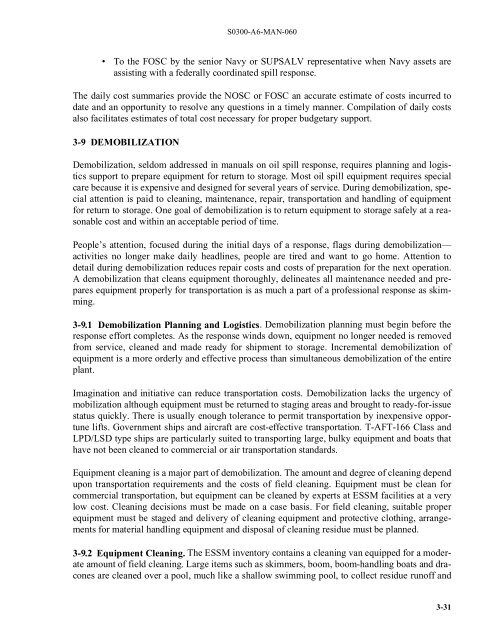U.S. Navy Ship Salvage Manual Volume 6 - Oil Spill Response
U.S. Navy Ship Salvage Manual Volume 6 - Oil Spill Response
U.S. Navy Ship Salvage Manual Volume 6 - Oil Spill Response
- No tags were found...
You also want an ePaper? Increase the reach of your titles
YUMPU automatically turns print PDFs into web optimized ePapers that Google loves.
S0300-A6-MAN-060• To the FOSC by the senior <strong>Navy</strong> or SUPSALV representative when <strong>Navy</strong> assets areassisting with a federally coordinated spill response.The daily cost summaries provide the NOSC or FOSC an accurate estimate of costs incurred todate and an opportunity to resolve any questions in a timely manner. Compilation of daily costsalso facilitates estimates of total cost necessary for proper budgetary support.3-9 DEMOBILIZATIONDemobilization, seldom addressed in manuals on oil spill response, requires planning and logisticssupport to prepare equipment for return to storage. Most oil spill equipment requires specialcare because it is expensive and designed for several years of service. During demobilization, specialattention is paid to cleaning, maintenance, repair, transportation and handling of equipmentfor return to storage. One goal of demobilization is to return equipment to storage safely at a reasonablecost and within an acceptable period of time.People’s attention, focused during the initial days of a response, flags during demobilization—activities no longer make daily headlines, people are tired and want to go home. Attention todetail during demobilization reduces repair costs and costs of preparation for the next operation.A demobilization that cleans equipment thoroughly, delineates all maintenance needed and preparesequipment properly for transportation is as much a part of a professional response as skimming.3-9.1 Demobilization Planning and Logistics. Demobilization planning must begin before theresponse effort completes. As the response winds down, equipment no longer needed is removedfrom service, cleaned and made ready for shipment to storage. Incremental demobilization ofequipment is a more orderly and effective process than simultaneous demobilization of the entireplant.Imagination and initiative can reduce transportation costs. Demobilization lacks the urgency ofmobilization although equipment must be returned to staging areas and brought to ready-for-issuestatus quickly. There is usually enough tolerance to permit transportation by inexpensive opportunelifts. Government ships and aircraft are cost-effective transportation. T-AFT-166 Class andLPD/LSD type ships are particularly suited to transporting large, bulky equipment and boats thathave not been cleaned to commercial or air transportation standards.Equipment cleaning is a major part of demobilization. The amount and degree of cleaning dependupon transportation requirements and the costs of field cleaning. Equipment must be clean forcommercial transportation, but equipment can be cleaned by experts at ESSM facilities at a verylow cost. Cleaning decisions must be made on a case basis. For field cleaning, suitable properequipment must be staged and delivery of cleaning equipment and protective clothing, arrangementsfor material handling equipment and disposal of cleaning residue must be planned.3-9.2 Equipment Cleaning. The ESSM inventory contains a cleaning van equipped for a moderateamount of field cleaning. Large items such as skimmers, boom, boom-handling boats and draconesare cleaned over a pool, much like a shallow swimming pool, to collect residue runoff and3-31
















